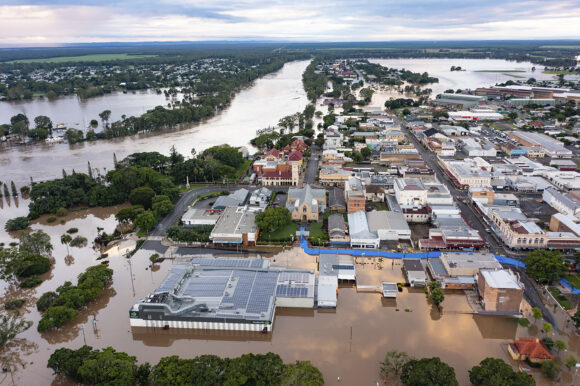Natural disasters in 2022 brought global economic losses of US$275 billion, of which insurance covered 45%, or US$125 billion, according to Swiss Re’s latest sigma report.
Claims from Hurricane Ian in Florida, record breaking losses from hailstorms in France, floods in Australia and South Africa, winter storms in Europe and the U.S., as well as droughts in Europe, China and the Americas, added up to make 2022 the second consecutive year (2021: $121 billion) in which insured losses from natural catastrophes exceeded the US$100 billion mark and the fourth highest total for a single year on sigma records, said the report titled “Natural catastrophes and inflation in 2022: a perfect storm.”
“The 2022 insured loss outcome reaffirms a 5-7% annual growth trend in place since 1992, this based mostly on rising severity of losses resulting from primary and secondary peril events,” said the report.
The biggest loss event in 2022 was Hurricane Ian, with an estimated insured loss of US$50 billion‒$65 billion. After Hurricane Katrina in 2005, Ian ranks as the second-costliest natural catastrophe insured loss event on sigma records, said Swiss Re. “It pushed global insured losses from tropical cyclones above prior-period averages, making 2022 the third most expensive hurricane season on record after 2005 (Katrina, Wilma and Rita) and 2017 (Harvey, Irma and Maria).”
Other large-loss events in 2022 were floods in Australia (US$4.3 billion in insured losses) and South Africa ($1.5 billion in insured losses), hailstorms in France ($5 billion), winter storms in Europe ($4.1 billion), and heatwaves and droughts in Europe ($600 million), China ($800 million) and the Americas ($1 billion in Brazil).
Rather than the destructive force of natural catastrophes themselves, Swiss Re said, the main drivers of resulting high losses are economic growth, accumulation of asset values in exposed areas, urbanization and rising populations, often in regions susceptible to natural perils.
“We expect that these and the evolution of a range of present-day risk factors like climate change effects and, of late, inflation, will continue to drive losses higher.”
Indeed, the report noted that inflation has surged over the last two years, averaging 7% in advanced economies and 9% in emerging economies in 2022. “The effect of high prices has been to increase the nominal value of buildings, vehicles and other insurable assets, in turn pushing up insurance claims for damage caused by mother nature,” the report said.
“The impact has been most immediate in the construction sector. Increases in the costs for materials and labour because of shortages thereof have led to higher claims to cover the costs of building repairs,” the sigma report continued. “In the US, for example, the aggregate replacement cost of buildings in 2022 had risen by an estimated 40% since the start of 2020.”
“The magnitude of losses in 2022 is not a story of exceptional natural hazards, but rather a picture of growing property exposure, accentuated by exceptional inflation”, said Martin Bertogg, head of Catastrophe Perils at Swiss Re, in a statement accompanying the report.
“While inflation may subside, increasing value concentration in areas vulnerable to natural catastrophes remains a key driver for increasing losses. For our industry, this is a call both to reflect the latest exposure even more carefully in risk assessments while continuing to support society in being better prepared,” he added.
Swiss Re expects the hard market in re/insurance to continue, as a result of increased demand for coverage and inflation-driven higher values of insured assets.
Industry capacity is being constrained by uncertainties around risk trends and six years of weak results in property underwriting, which have reduced risk appetite, the report said.
Since 2017, the re/insurance industry has paid out US$650 billion (in 2022 prices) for weather-related naustralia flooatural catastrophes claims, Swiss Re said, noting, however, that premium income has not kept pace with events or exposure growth with the result being steadily declining profits.
Natural catastrophe losses affect perceptions about whether risks are priced adequately – a key factor in determining the supply of capital and capacity available for underwriting, the report continued. “The historically elevated catastrophe and claims activity since 2017 has created doubts on the part of re/insurers and investors, and slowed the capital supply response.”
As a result of these factors, the momentum for rising prices, higher retentions and tighter terms and conditions will likely continue, the report said.
Source: Swiss Re
Photo: In this photo provided by the Fraser Coast Regional Council, water floods streets and houses in Maryborough, Australia, Monday, Feb. 28, 2022. Heavy rain is bringing record flooding to some east coast areas while the flooding in Brisbane, a population of 2.6 million, and its surrounds is the worst since 2011 when the city was inundated by what was described as a once-in-a-century event. (Queensland Fire and Emergency Services via AP)
Was this article valuable?
Here are more articles you may enjoy.


 Cat Bonds Linked to Wildfires Lose ‘Once Untouchable’ Status
Cat Bonds Linked to Wildfires Lose ‘Once Untouchable’ Status  Flooding in California Leads to Soaked Roads, Water Rescues and 1 Death
Flooding in California Leads to Soaked Roads, Water Rescues and 1 Death  Tesla Drivers Are Buying Escape Tools and Cars to Avoid Getting Trapped Inside
Tesla Drivers Are Buying Escape Tools and Cars to Avoid Getting Trapped Inside  Jump Trading Faces $4 Billion Terraform Administrator Suit
Jump Trading Faces $4 Billion Terraform Administrator Suit 